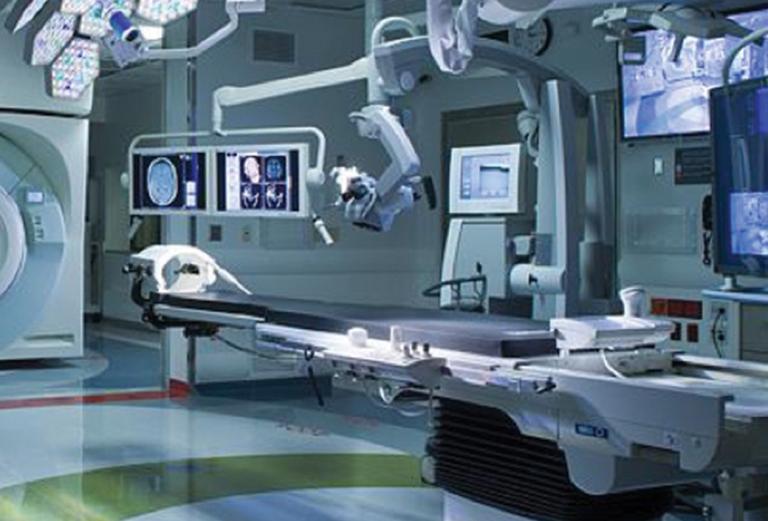A Window on Wheels
An innovation to a mass spectrometer allows analysis of tissue pathology in the OR
- 5 minute read
- Feature

Surgical suite with in-room imaging
When Nathalie Agar began her postdoctoral work in neurosurgery at McGill University, she knew she wanted to one day help cancer patients. When she dove into her second postdoctoral fellowship in neurosurgery, however, she didn’t expect she would develop an equal compassion for cancer surgeons.
“I have so much respect for my colleagues who have to stand there in the OR and decide whether this tissue in a patient’s brain is tumor or not tumor when it all looks the same and they don’t have data on it,” says Agar, who did her postdoc work at HMS and Brigham and Women’s Hospital and is now an HMS associate professor of neurosurgery and of radiology, founding director of the Surgical Molecular Imaging Laboratory at Brigham and Women’s, and a member of the cancer biology program in the Dana-Farber/Harvard Cancer Center.
Currently, surgeons can send a tumor section to the pathology lab midoperation for analysis, but that takes time, delivers limited insights, and is hard to do more than once during a surgery. Moved by the difficulty of their decision making, Agar asked, “What tools can I offer to help?”
She found answers in mass spectrometry, a technology that measures the masses of the components of a sample. She modified a commercial spectrometer so it could analyze tissue that hadn’t undergone a lengthy preparation process, then worked with a multidisciplinary team to create an experimental surgical protocol.
The protocol goes like this: As a willing surgeon prepares to remove a brain tumor, Agar puts the instrument on a cart and wheels it into the operating suite. As tissue is carved out bit by bit, Agar feeds samples into the spectrometer. In seconds, it spits out a spectrograph that indicates the quantities of hundreds of different molecules within the tissue. Agar homes in on the ones of interest, using her ever-growing catalog of molecular masses to flag tumor markers such as hormones and enzyme metabolites. The readouts help the surgeon identify tumor type, stage, and aggressiveness and, based on the proportion of abnormal tissue, how close the excision is to the tumor border.
Best of all, Agar’s team set up a workflow such that when a surgeon slides the patient into an intraoperative MRI machine, the spectrometry results get mapped on top, showing tissue composition where each sample was taken. If, for example, a surgeon faces the dilemma of a glioma encroaching on the language region of a patient’s brain, the information provided by the spectrometer could help inform decisions on additional tissue removal, decisions that could influence the odds of survival, recurrence, and quality of life.
Although Agar is cautious by nature, committed to exhaustively validating each technique before saying it will work, oncologists are taking notice. The work earned her an NIH Director’s New Innovator Award in 2010. With co-principal investigator Gary Yellen, professor of neurobiology at HMS, Agar received one of the inaugural HMS Dean’s Innovation Awards in summer 2018 to further the research.
Yet she didn’t technically invent something so much as recognize the potential of existing tools.
“The mass spectrometer already existed,” Agar says. “The ionization techniques to avoid sample preparation already existed. So did the neuronavigation system and some of the software in that lab. We just try to take the pieces that are out there and pull them together to answer our own questions.”
Agar continues to iterate using more visually oriented types of mass spectrometry and advanced software. One technique analyzes samples every 5 to 100 microns, creates a spectrograph of each section, and then translates each spectrograph into a pixel. Taken together, the pixels show the molecules in each section of the tissue sample. The resulting images reveal never-before-seen variation within tumors.
In addition to aiding in diagnosis, prognosis, treatment, and drug development, these technologies let Agar and colleagues identify new biomarkers and probe interactions between cancer drugs and the blood-brain barrier. Until now, a researcher might grind up a biopsy, detect a certain amount of drug, and extrapolate that the drug had been evenly distributed throughout the tumor. Using Agar’s technique, that researcher can visualize the distribution of drug metabolites and know whether the chemotherapies remained trapped in the bloodstream or penetrated only a short distance into a tumor, both in preclinical models and specimens from clinical trials.
Collaborators eager to gain deeper biological insights using Agar’s imaging innovations include Chenghua Gu, professor of neurobiology at HMS, who probes the neurovascular interactions that underlie the blood-brain and blood-retinal barriers with the goal of manipulating these barriers to allow treatments to reach their targets, and Marcia Haigis, an HMS professor of cell biology. Agar and Haigis are currently collaborating on two papers describing the use of spatial resolution in the study of brain tumors and muscle metabolism.
Agar is now also exploring mass spectrometry applications for breast and prostate cancers and seeking to bring higher-powered spectrometers to campus to more finely distinguish molecules with similar masses.
“Being able to provide oncologists with images that show this is where the drug is, this is where the tumor is, this is where the necrosis is, this is where the blood vessels are—information they haven’t been able to access before—is very gratifying,” she says.
Stephanie Dutchen is a science writer in the HMS Office of Communications and External Relations.
Image: Courtesy of Nathalie Agar